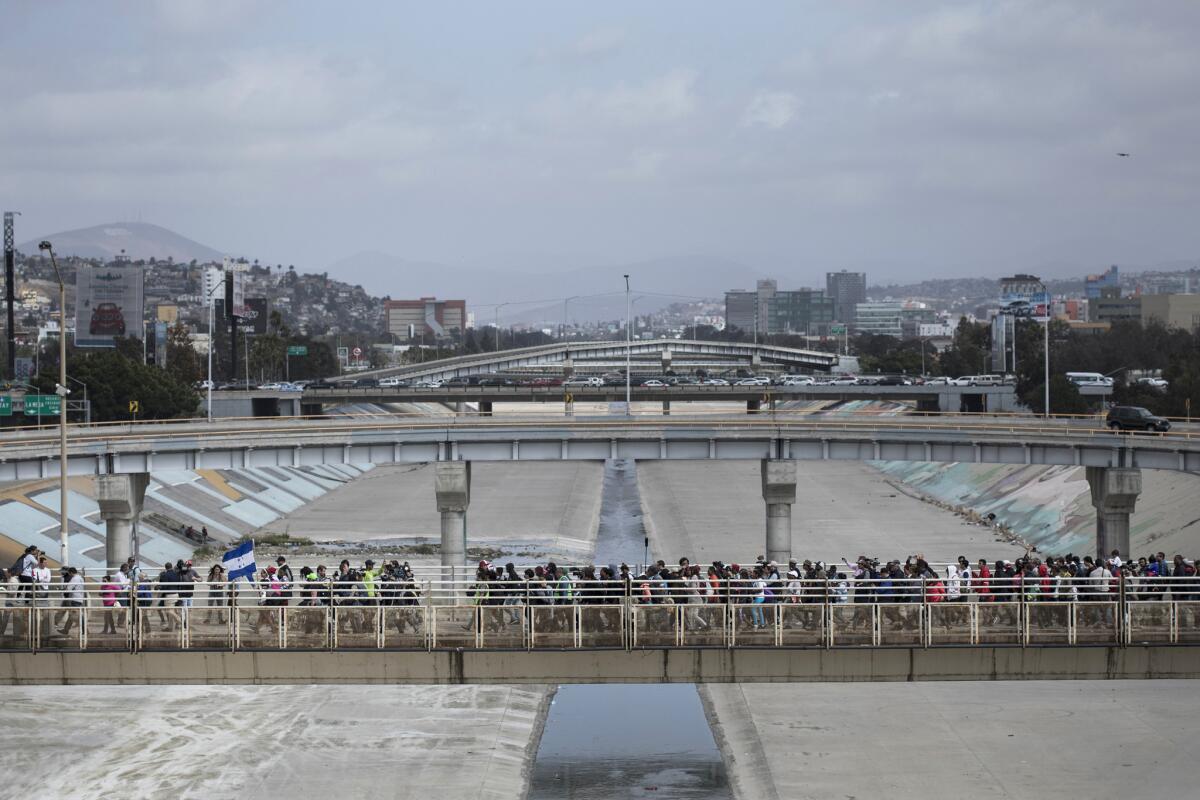This may have been Trump’s most successful year yet for restricting immigration

- Share via
WASHINGTON — After countless promises and attempts to restrict immigration, 2019 may be remembered as the year in which President Trump got closest to fulfilling his central campaign pledge.
As the numbers of migrants arriving at the U.S. southern border reached their highest levels in more than a decade, peaking this last spring before dropping precipitously, Trump and his officials targeted immigration, aiming to block asylum seekers and refugees.
“Our country is full,” Trump said in an April visit to Calexico, Calif. “Can’t take you anymore, I’m sorry.”
Since January, under one policy alone, U.S. officials have forced more than 55,000 asylum seekers back to Mexico to await court hearings in the United States.
Officials termed the program the “Migrant Protection Protocols,” rejecting mounting evidence that Trump’s policy puts asylum seekers at risk of rape, kidnapping and death in Mexican border cities that rank among the most dangerous in the world, according to the U.S. State Department.
Judges, lawyers, advocates, lawmakers and current and former officials — including asylum officers and senior Homeland Security Department leadership — say that the policy appears to be violating the law.
This year, good news was overshadowed by a government shutdown, impeachment debates, mass shootings and cheating scandals.
Some asylum officers nationwide have resisted and outright refused to implement the policy. Meanwhile, the White House is pushing Border Patrol agents — who are law enforcement personnel — to take over asylum interviews, believing it will lead to fewer applicants being approved.
The U.S. 9th Circuit Court of Appeals has allowed the administration to rapidly expand the Migrant Protection Protocols — across the entirety of the U.S.-Mexico border, to virtually any nationality, and including vulnerable groups like pregnant women — while it weighs a final decision on its legality.
At the same time, another roughly 20,000 migrants and asylum seekers are waiting at ports of entry across the border, delayed by U.S. officials from making their initial claim, some for six months or more, in a practice known as metering.
Tens of thousands of asylum seekers and migrants in limbo in Mexico have added to a combustible political scenario for President Andres Manuel Lopez Obrador. He promised to stand up for migrants but has lent unprecedented security cooperation to the Trump administration to crack down on migration, despite Trump’s threats and record homicides in Mexico.
In fact, Mexicans are steadily supplanting Central Americans coming to the border to seek asylum. With the administration setting a refugee cap of 18,000 in 2020, the lowest level in 50 years, Mexicans are one of the few groups left with a legal avenue — however narrow — to seek protection in the United States.
Toward the end of the year, in the face of ongoing litigation, the administration began implementing a new rule that effectively ends asylum at the southern border for everyone except Mexicans.
Virtually any migrant who passes through another country and does not seek asylum there first before arriving at the border is ineligible for protection in the United States, whether Central American or African. Trump officials followed the rule with controversial asylum agreements with El Salvador, Guatemala and Honduras.
Trump aides acknowledge that the policies are designed to urge asylum seekers to give up on their claims and go home, and deter others from coming.
Several of the administration’s most sweeping changes to the U.S. immigration system have been partially or fully blocked by the courts: ending protections for unaccompanied minors, enabling the government to detain them indefinitely; expanding expedited deportations to virtually anywhere in the country, potentially forcing even U.S. citizens to carry proof; and prohibiting green-card holders and other immigrants from accessing a range of public benefits, including for their U.S. citizen children.
But taking together the policies targeting asylum at the southern border, Trump has made good on his signature campaign slogan — to “Build a wall,” albeit a virtual one.
Despite declaring a national emergency in February to direct billions in military construction money and other federal funds toward a physical border barrier, as of mid-December, the Trump administration had yet to add a single new linear mile, according to U.S. Customs and Border Protection. The existing total of roughly 650 miles was built and funded under his predecessors.
Trump also deployed thousands of active-duty U.S. military to the border to respond to what he termed a migrant “invasion.” Nearly 2,500 remain posted in the Southwest despite what is now a roughly 70% drop in the number of migrants apprehended at the border since a high of nearly 133,000 in May.
In August, a shooter echoed the president’s “invasion” rhetoric in a manifesto and said he was targeting Latinos when he killed 22 people in El Paso, according to law enforcement.
Trump hasn’t stopped using heated rhetoric toward asylum seekers and making big claims on immigration and border security. Still, threats to “dump” migrants in so-called sanctuary cities in California or designate Mexican cartels as terrorist groups have proved empty.
But with a record number of vacancies in Homeland Security Department leadership following a purge of top officials to go in a “tougher” direction, and hardliner Stephen Miller still holding the president’s ear despite emails demonstrating ties to white supremecist ideology, Trump is likely to try and make 2020 — a presidential election year — his most successful yet toward being able to say, as he put it in May: “We’re closed!”
More to Read
Get the L.A. Times Politics newsletter
Deeply reported insights into legislation, politics and policy from Sacramento, Washington and beyond. In your inbox twice per week.
You may occasionally receive promotional content from the Los Angeles Times.










